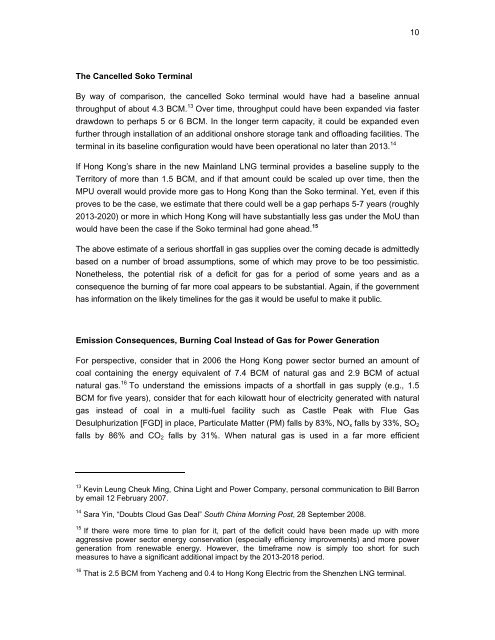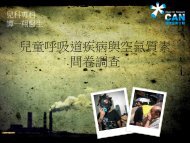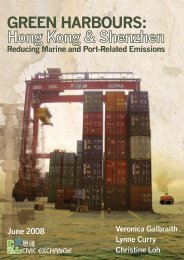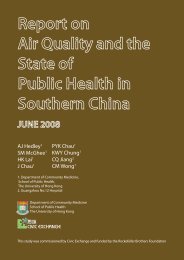You also want an ePaper? Increase the reach of your titles
YUMPU automatically turns print PDFs into web optimized ePapers that Google loves.
10<br />
The Cancelled Soko Terminal<br />
By way of comparison, the cancelled Soko terminal would have had a baseline annual<br />
throughput of about 4.3 BCM. 13 Over time, throughput could have been expanded via faster<br />
drawdown to perhaps 5 or 6 BCM. In the longer term capacity, it could be expanded even<br />
further through installation of an additional onshore storage tank and offloading facilities. The<br />
terminal in its baseline configuration would have been operational no later than 2013. 14<br />
If <strong>Hong</strong> Kong’s share in the new Mainland LNG terminal provides a baseline supply to the<br />
Territory of more than 1.5 BCM, and if that amount could be scaled up over time, then the<br />
MPU overall would provide more gas to <strong>Hong</strong> Kong than the Soko terminal. Yet, even if this<br />
proves to be the case, we estimate that there could well be a gap perhaps 5-7 years (roughly<br />
2013-2020) or more in which <strong>Hong</strong> Kong will have substantially less gas under the MoU than<br />
would have been the case if the Soko terminal had gone ahead. 15<br />
The above estimate of a serious shortfall in gas supplies over the coming decade is admittedly<br />
based on a number of broad assumptions, some of which may prove to be too pessimistic.<br />
Nonetheless, the potential risk of a deficit for gas for a period of some years and as a<br />
consequence the burning of far more coal appears to be substantial. Again, if the government<br />
has information on the likely timelines for the gas it would be useful to make it public.<br />
Emission Consequences, Burning Coal Instead of Gas for Power Generation<br />
For perspective, consider that in 2006 the <strong>Hong</strong> Kong power sector burned an amount of<br />
coal containing the energy equivalent of 7.4 BCM of natural gas and 2.9 BCM of actual<br />
natural gas. 16 To understand the emissions impacts of a shortfall in gas supply (e.g., 1.5<br />
BCM for five years), consider that for each kilowatt hour of electricity generated with natural<br />
gas instead of coal in a multi-fuel facility such as Castle Peak with Flue Gas<br />
Desulphurization [FGD] in place, Particulate Matter (PM) falls by 83%, NO x falls by 33%, SO 2<br />
falls by 86% and CO 2 falls by 31%. When natural gas is used in a far more efficient<br />
13 Kevin Leung Cheuk Ming, China Light and Power Company, personal communication to Bill Barron<br />
by email 12 February 2007.<br />
14 Sara Yin, “Doubts Cloud Gas Deal” South China Morning Post, 28 September 2008.<br />
15 If there were more time to plan for it, part of the deficit could have been made up with more<br />
aggressive power sector energy conservation (especially efficiency improvements) and more power<br />
generation from renewable energy. However, the timeframe now is simply too short for such<br />
measures to have a significant additional impact by the 2013-2018 period.<br />
16 That is 2.5 BCM from Yacheng and 0.4 to <strong>Hong</strong> Kong Electric from the Shenzhen LNG terminal.








